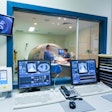
Two recent studies in Radiology have continued to explore the role of contrast-enhanced MRI for the preoperative assessment of primary breast cancer. German investigators looked into why gadolinium-enhanced MRI failed to identity certain tumors, while Swiss researchers tried out MRI of the lymph nodes using ultrasmall superparamagnetic iron oxide (USPIO) particles.
Integrated MRI
"Treatment strategy and outcome in patients with breast cancer is dependent not only on the extent of the primary tumor but also on axillary lymph node staging, which plays an important role in the outcome of these patients...Dextran-coated (USPIO) particles have been introduced as a contrast agent for intravenous MR lymphography...providing information on lymph node morphology," wrote Dr. Sven Michel and colleagues from the University Hospital Zurich (Radiology, November 2002, Vol. 225:2, pp. 527-536).
The study population consisted of 20 consecutive female patients who had cytologically and histologically confirmed primary breast carcinoma. They were scheduled for breast surgery, including axillary dissection.
The contrast agent (Combidex, Advanced Magnetics, Cambridge, MA; also sold as Sinerem, Guerbet, Roissy, France) was administered intravenously 24-36 hours prior to MRI as a slow drip infusion of 2.6 mg of iron per kilogram of body weight. The flow rate was 2 mL/min for the first 10 minutes, then increased to 4 minutes for a total infusion time of 30 minutes. The USPIO was diluted in 100 mL of 0.9% saline solution.
Imaging was performed on a 1.5-tesla MR system (Signa CV/i or Horizon, GE Medical Systems, Waukesha, WI). Transverse and coronal T1-weighted spin-echo images were obtained, as well as coronal T2-weighted fast spin-echo sequences. A coronal gradient-echo sequence was used to improve the susceptibility and T2 effect of USPIO, the authors stated. MR angiography of the primary tumor also was performed followed by gadolinium-enhanced MR. The total exam time was less than 70 minutes.
"Criteria to distinguish benign from malignant nodes included size, shape, and USPIO uptake," the authors explained. "A short-axis diameter exceeding 1 cm was considered indicative of a metastatic node, as was a round rather than oval shape." The results of the MR staging, and a drawing of the lymph nodes, were made available to the surgeons. Surgery was generally performed within 2 days of the MRI exams.
According to the results, preoperative staging with MRI resulted in a change to therapy in two patients, with neoadjuvant chemotherapy given before surgery. In one patient, the MR images showed extensive tumor growth involving nearly the entire left breast. USPIO-enhanced MRI demonstrated multiple metastatic axillary nodes that were subsequently confirmed with ultrasound-guided fine-needle aspiration biopsy.
In the second patient, MR with USPIO detected six out of 27 lymph nodes that were tagged malignant. Metastatic involvement of the axilla was confirmed with ultrasound-guided fine-needle aspiration biopsy.
In the remaining 18 patients, vessels within the breast parenchyma were well delineated because of the lengthy presence of USPIO in the intravascular compartment. The USPIO did not show any clinically relevant interaction with the gadolinium-enhanced properties of the primary breast-tumor lesions and did not hamper image interpretation by two readers, the authors reported. Four patients had tumors in the left breast, and 14 had them in the right one. All primary tumors were detected by MRI and correctly diagnosed as malignant.
Based on USPIO-enhanced MR results, 375 nodes were deemed benign and 30 malignant. On the basis of the presence of nodal involvement, the sensitivity of the USPIO-enhanced MRI exam was 82%, the specificity was 100%, the accuracy was 89%, the positive predictive value was 100%, and the negative predictive value was 78%.
An integrated imaging strategy using gadolinium-enhanced with USPIO-enhanced MR "can be of value for clinical decision-making. If USPIO-enhanced MR imaging depicts metastatic nodes in a patient scheduled for sentinel node lymphadenectomy, because of the high positive predictive value of the imaging test, it may be justified to replace this time-consuming surgical procedure with conventional surgical lymph node dissection," the authors concluded.
Missing tumors on MR
Dr. Andrea Teifke and colleagues from the Johannes Gutenberg University in Mainz assessed the prevalence and characteristics of malignant breast lesions that were not identified on MR.
"The most common indication (for MRI) was the search for additional tumor foci where a high degree of suspicion for malignancy already existed on the basis of results of conventional breast imaging. The second most common indication was uncertain findings at mammography and/or (ultrasound)," the authors wrote (Radiology, September 2002, Vol. 224:3, pp. 881-888).
For this study, 464 women underwent dynamic gadolinium-enhanced T1-weighted fast low-angle shot 3-D MR of both breasts. MR imaging was performed on a 1-tesla scanner with a double-breast coil (Magnetom Impact Expert 42SP/AS, Siemens Medical Solutions, Erlangen, Germany). Patients were imaged in a prone position. One scan was performed before a manual bolus injection of Magnevist (Schering AG, Berlin, Germany); five scans were done post-contrast.
"Absence of contrast medium uptake or a bilateral slow and diffuse enhancement was considered negative for cancer...criteria for a benign lesion were rising time-signal intensity curve, well-circumscribed shape, internal septations, and homogenous enhancement," the authors wrote.
The criteria for malignancy were maximum signal intensity in the first two post-contrast measurements; a stellate, irregular, or linear configuration; and inhomogeneous or rim enhancement.
According to the results in 598 lesions, 59% were malignant and 41% were benign based on histology. The authors found that MR had the highest sensitivity, 88.4%, with a specificity of 59.4% for lesions judged as BI-RADS category 4. MR imaging found 26 additional, malignant foci that had not been identified using conventional techniques.
However, the sensitivity of MR alone did not exceed the 88.1% sensitivity of ultrasound and mammography combined. MRI missed 41 malignant tumors, 25 of which were found on mammography and/or ultrasound. Of the 41 missed tumors, 28 were invasive breast carcinoma. The reasons for the MR exams’ failure included the position of the lesion near the chest wall but outside the coil volume; a faulty contrast injection; and a recurrent tumor that was not localized with the T1-weighted imaging sequence, the authors said.
Other reasons for missed cancers on MR were motion artifacts, strongly enhanced glandular parenchyma, and 13 cases of ductal carcinoma in situ (DCIS).
"Either diffuse growth or a small tumor diameter characterized the remaining invasive carcinomas that were undetected on MR imaging," they wrote. "Furthermore, very small tumors can be easily masked by motion artifacts or can be mistaken for vessel cross sections."
The group recommended that negative MR findings should not be relied upon by themselves, especially if mammography yields "even the slightest evidence of diffusely or intraductally growing tumors."
By Shalmali PalAuntMinnie.com staff writer
October 31, 2002
Related Reading
MR spectroscopy again links choline to carcinoma, October 9, 2002
MR spectroscopy of biopsy specimen could spare breast surgery, October 1, 2002
MRI useful in women with early-stage breast cancer, September 3, 2002
Prototype MR elastography reveals mechanical properties of breast cancer, July 25, 2002
Copyright © 2002 AuntMinnie.com

.fFmgij6Hin.png?auto=compress%2Cformat&fit=crop&h=100&q=70&w=100)





.fFmgij6Hin.png?auto=compress%2Cformat&fit=crop&h=167&q=70&w=250)










